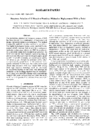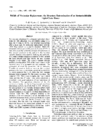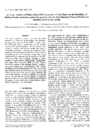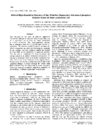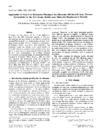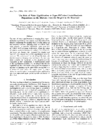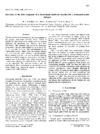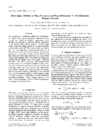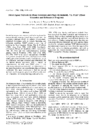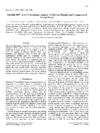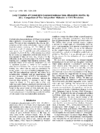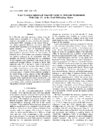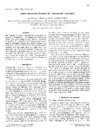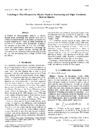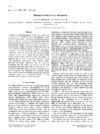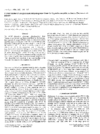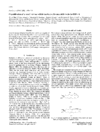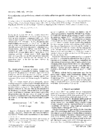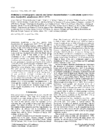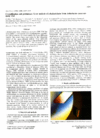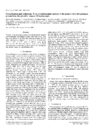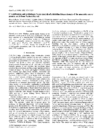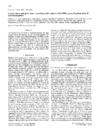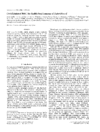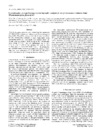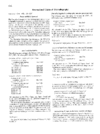issue contents
November 1996 issue

Cover illustration: NMR solution structure of an Antennapedia homeodomain complex with a 14-base pair operator DNA duplex. The dotted surface outlines a hydrated cavity in the protein-DNA interface.
research papers
The pentameric structure of C-reactive proteins has been derived by a combination of automated and manual molecular-replace-ment techniques, showing that highly homologous protomers with similar folds need not necessarily be assembled in the same way.
The structure of a human immunoglulin light-chain dimer from the lambda III subgroup shows interfacial hydrogen bonds between the main chains of CDR2 and CDR3 segments. Indicators that structures are correct are discussed.
PDB reference: 1lil
Models of monoclinic lysozyme obtained from two independent elements were reconciled to produce a more reliable model. A comparison of this model with the structures of a low-humidity form and an enzyme-inhibitor complex has been used to establish a relation among dehydration, mobility and enzyme action.
PDB reference: 1uco
Interpretable electron-density maps of a protein structure could be generated using phases derived from a selenomethionyl derivative and Cu Kα diffraction.
The only published class II aldolase structure is reported at high resolution in two forms, with a zinc ion and with a cobalt ion in the active center. An irregular birefringence along the fourfold axis indicates slight rearrangements of the N-terminal domain that contains the active center.
An ab initio crystallographic image of the T50S ribosomal particle is obtained at 80 Å resolution using the few-atoms-models method.
The rate of water equilibration in hanging-drop crystallizations depends on the distance of the drop to the reservoir surface. By varying this distance the rates of supersaturation development, of nucleation and of crystal growth can be optimized.
The structure of a monoclonal antibody Fab fragment specific for carcinoembryonic antigen has been solved and refined using data to 2.1 Å. The confrmation of the binding site is described.
PDB reference: 1clo
A method is described for changing phases so as to drive the moments of the electron-density distribution, separately in the protein and solvent regions, towards target values. For trial structures good refinement is obtained by modifying only the third moment within the protein region.
The PERP program which contains seven different procedures for phase extension and refinement for proteins is described. It is driven by keywords and very simple to use; from given examples of its use it appears that near-optimum results are obtained by running with provided defaults.
The structure of subtilisin BPN' in space group C2 has been refined at 1.6 Å resolution, revealing 17 regions of discrete disorder and providing the basis for comparison with the high-resolution structure in space groups P212121 and P21.
PDB reference: 1sup
The structure of cyclodextrin glucanotransferase from alkalophilic Bacillus sp. 1012 was determined at 1.8 Å resolution by X-ray analysis and solved by molecular replacement.
PDB reference 1pam
The structure of amaryllis lectin has been solved by the molecular replacement method using only 109 C α atoms out of the 1688 atoms in the asymmetric unit (6%). Further experiments with smaller probes showed that just 3.9% of the total diffracting matter was sufficient to give the correct MR solution.
TLP20 (telokin-like protein) is derived from the baculovirus Autographa californica nuclear polyhedrosis virus and is antigeneically similar to telokin; the C-terminal domain of smooth-muscle myosin light-chain kinase. The amino-acid sequence of TLP20 is different from telokin of any other known protein. As shown here the three-dimensional structure of a proteolytic portion of TLP20 shares no structural similarity to telokin. The protein consists of a seven-stranded antiparallel β-barrel flanked on the bottom by two additional β-strands and on the top by an α-helix.
PDB reference: 1tul
The structure of concanavalin A has been refined to a resolution of 1.2 Å against low-temperature data.
PDB reference: 1jbc
X-ray diffraction from contracting and rigor muscles can be explained by periodic labelling of thin filaments by myosin heads.
A method for obtaining correct phases of low-order reflections for globular proteins using a spherical scattering function is presented. The method predicts the phases of the ten or so lowest order reflections which might enable the determination of a low-resolution envelope of an unknown protein.
short communications
Crystallization of Escherichia coli enoyl acyl carrier protein reductase with NAD+ in the presence and absence of diaza-borine.
A comparison of the structure from GluDH Thermococcus litoralis and that of other GluDH's from hyperthermophilic organisms and from mesophiles will contribute to an understanding of the molecular mechanisms which underlie thermal stability.
Cabbage histidinol dehydrogenase has been crystallized in five different crystal forms. These results and initial attempts to find heavy-atom derivatives are described.
A new type of dehalogenase peroxidase has been crystallized. High-resolution data for the native enzyme and for the complex with 4-iodophenol, a substrate, have been collected.
Bacillus sutilis esterase, an enzyme catalysing the hydrolysis of the phytotxin brefeldin A to non-toxic brefeldin A acid, has been crystallized by the hanging-drop technique..
Lactoferrin, an iron-binding glycoprotein with a molecular weight of 80 kDa has been isolated from equine milk and has been purified and crystallized. The crystals grow in three different forms. The structure has been determined by the molecular replacement method and has been refined to an R value of 0.211.
Lactose-specific enzyme IIA of the PEP-dependent sugar phosphotransferase system from Lactococcus lactis has been crystallized. The space group has been determined as P41212 or P43212 and an isomorphous heavy-atom derivative has been identified.
Preliminary crystallographic analysis of dodecaheme cyto-chrome c from Desulfovibrio desulfuricans ATCC 27774 indicates two monoclinic crystal forms, in both cases woth two independent molecules in the asymmetric unit, related by a non-crystallographic twofold axis perpendicular to the crystallo-graphic twofold axis. The midpoint redox potentials of this cytochrome were estimated after visible absorbance changes as a function of the solution redox potential and EPR spectroscopy of the oxidized cytochrome show several low-spin components.
Crystallization and preliminary X-ray analysis of a hydantoinase from Artrobacter aurescens DSM 3745
A hydantoinase from Artrobacter aurescens DSM 3745 has been crystallized and preliminary X-ray analysis has been performed.
The protein is thought to contain a novel prismane [6Fe-6S] cluster, also believed to be present at the active site of Fe-only hydrogenases, dissimilatory sulfite reductase and carbon monoxide dehydrogenase.
Crystals of a histidine protein kinase domain of the anaerobic sensor ArcB have been obtained by hanging-drop vapour diffusion and preliminary analysis carried out.
An intact DNA gyrase B protein has been crystallized by the dialysis method.
The crystallization of DsbC, the 2 X 23 kDa E. coli periplasmic disulfide bond isomerase is described. The crystals diffract to 2.1 Å and are suitable for X-ray structure derermination.
The crystallization, X-ray analysis and MR solution of human heparin binding protein (also known as CAP37 or azurosidin) is described.
Two isoforms of β-mannanase from Thermomonospora fusca KW3 have been crystallized in two orthorhombic forms suitable for structural analysis, with ammonium sulfate as precipitant. One form diffracts to 1.6 Å and the other form to at least 2.2 Å resolution.
international union of crystallography
Free 



 journal menu
journal menu









